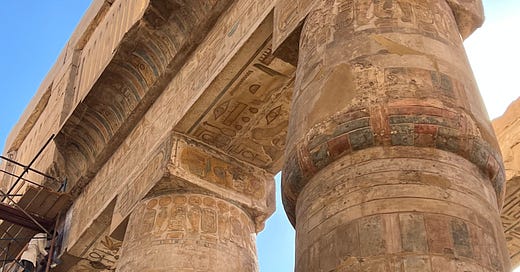Ancient/Now - February 3rd
People who reject books, the dehumanizing history of African American remains in museum collections, the amazing discovery of ten crocodile mummies, and more
Is the rejection of books a sign of a character deficiency?
In an article for The Atlantic contributing writer and visiting professor of humanities at Bard College Thomas Chatterton Williams discusses how disturbed he is by people who reject books and consider it a feature of their character, not a bug. Pointing to Ye’s (Kanye West, that is) comment, “I am a proud non-reader of books,” Williams attempts to break down the gall, ignorance, and arrogance of any person who flaunts their rejection of books. Ye’s comment is especially notable given that he said it to an interviewer while promoting his own book, Thank You and You’re Welcome. Williams writes,
It is one thing to practice not to read books, or not to read them as much as one might wish. But it is something else entirely to despise the act in principle.
The disturbingly expansive reach of celebrities, other high-profile public figures, and “influencers” who reject books puts us in an ironic position: In an era when humans have never-before-seen levels of access to so much information, the drive toward anti-intellectualism is propelling society toward the celebration of willful ignorance as an ideal. How lovely!

The dehumanizing history of collecting African American bodies
In a recent article, archaeologists Delande Justinvile and Chip Colwell grappled with the long and painful history of American museum collections that hold the remains of African Americans (and the remains of other peoples of color), including the collections of Harvard University museums. Harvard has the remains of fifteen likely enslaved people in their collections. Some of these collections were formed with the purpose of attempting to scientifically demonstrate the physical and intellectual inferiority of people of color in comparison to White people. Justinvile and Colwell ask how museums with such holdings can even begin to address the harm and lack of humanity behind the formation of these collections:
As archaeologists, we understand the impulse to gather human remains to tell our human story…life histories constructed from skeletal remains, can offer insights into nutritional, migratory, pathological, and even political-economic conditions of past populations. However, scholars and activists across the U.S. are now seeking to recognize and redress the deep history of violence against Black bodies. Museums and society are finally confronting how the desires of science have at times eclipsed the demands of human rights.
The article goes on to sketch the horrific history of the desecration of Black bodies in life and death in the name of “science” and calls for the creation of legislation to reclaim the remains of Black people similar to the 1990 Native American Graves Protection and Repatriation Act (NAGPRA), which protects Native American remains from exploitation and desecration. Without a federal law compelling museums to move beyond acknowledgement to action, they argue, there will never be any justice.
NYT: 2,500-year-old Crocodile mummies discovered on the Nile’s west bank
In 2019 at a site known as Qubbat al-Hawa, at Aswan in Egypt’s south, archaeologists from the Universidad de Jaén (Spain) unearthed ten mummified crocodiles near an undisturbed tomb. Five of the crocodile mummies were more or less intact, making it an amazing discovery. (The link above is definitely worth a click because it features an amazing video of the crocodiles being excavated!)
“Most of the time I’m dealing with fragments, with broken things,” said Bea De Cupere, an archaeozoologist at the Royal Belgian Institute of Natural Sciences and a co-author of the study. “To hear you have 10 crocodiles in a tomb. That’s special.”
Another unique aspect of this find is that no resin was used in mummifying the crocodiles, and the linen bandages originally wrapped around the animals were eaten away by insects. Most of the time archaeologists can only study wrapped animal mummies using non-invasive techniques like X-ray because the “unwrapping” of an animal mummy would essentially destroy it. But the insects did the work of unwrapping completely organically by eating all of the linen, and experts can study the remains directly. Although animal mummification was at its height during the Ptolemaic Period (ca. 332-30 BCE), the academic article outlining this discovery suggests a “pre-Ptolemaic date for the deposit.” No doubt this extraordinary find will offer new and interesting details on crocodiles in ancient Egypt and add to what we know about the history of Qubbat al-Hawa.
Great Hypostyle Hall Restoration Project completes 37 columns of Karnak Temple
A Supreme Council of Antiquities project that started out in July 2021 by restoring 16 columns has now completed the restoration of an additional group of 37 columns in Karnak Temple’s Great Hypostyle Hall. As part of the restoration efforts column surfaces were cleaned, revealing the original reliefs and colors greater detail. Located near modern-day Luxor, Karnak Temple was dedicated to the god Amun-Re in ancient times and was added to by successive kings over the centuries. The forest of columns that makes up the Great Hypostyle Hall is a bucket-list-worthy experience and is always at the top of the list for anyone visiting Luxor.
Jordan was just there and the brilliantly preserved color is indeed amazing! However, we wonder if putting these columns into place in such a permanent fashion and covering all joins with restoration material is the right tactic. Many of the column drums have been reconstructed in the wrong places, a fact proven by University of Memphis Egyptologist Peter Brand, Project Director of The Karnak Great Hypostyle Hall Project. Perhaps it’s better to leave the Hypostyle Hall a little less perfect so that column drum shapes can be more clearly discerned for future, ongoing research.
For more great info on the Hypostyle Hall and awesome photos, check out this Twitter thread by Dr. Brand.
First full residential city discovered in eastern Luxor
On the east bank of the Nile near Luxor Temple archaeologists led by the Secretary General of the Supreme Council of Antiquities, Mostafa Waziri, have uncovered a complete residential city from the Roman era. Ancient Egypt is sometimes referred to as the “civilization with no cities” since most of the habitation areas would have been in the floodplain and destroyed by the annual inundation. But this discovery includes manufacturing workshops, Roman coins, grinding tools, and a variety of pottery vessels. Excavations of this ancient neighborhood of Thebes are ongoing as archaeologists look to improve our understanding of what ancient life in this residential city was like.










